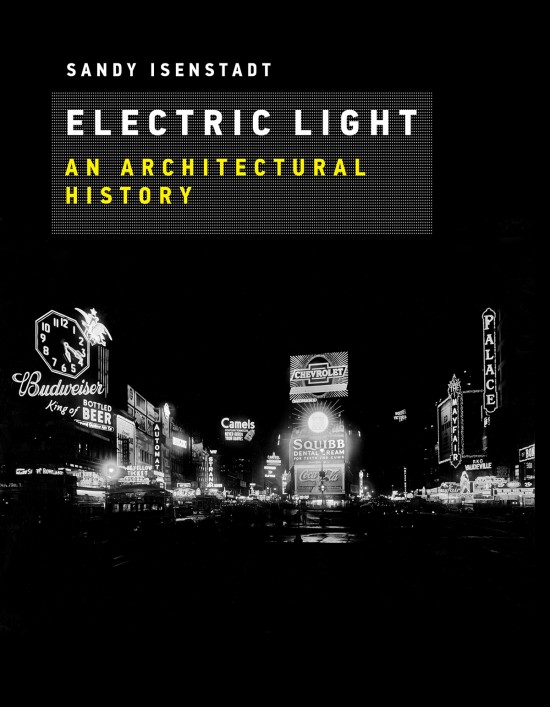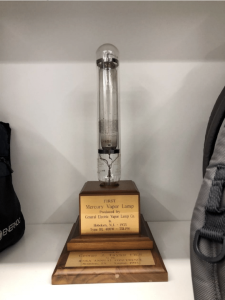Sandy Isenstadt
The MIT Press

At a recent board meeting of the Illuminating Engineering Society on Wall Street in Lower Manhattan, I sat next to the first example of a mercury vapor lamp from 1935. Sitting on its pedestal, this light bulb seemed entirely out of place in the sleek, recently renovated office space—outfitted with solid-state or LED lighting fixtures throughout. It provided the perfect reminder for why books like Sandy Isenstadt’s Electric Light: An Architectural History are so essential because they capture the rapid and significant impact lighting technologies have had on our experience of spaces and places by modulating our perception and transforming our entire outlook on the circadian light-dark cycle.
Isenstadt’s book explores an understudied field, making valuable contributions and connections between studies of science, technology, and society (STS) as well as art and architectural history. The book is also written in a sophisticated yet accessible manner for readers who simply want to expand their horizon. His essay style may be frustrating for some, but I enjoyed each insight as they began filling in a whole image, like individual pixels to form a unique take on light and lighting in our architectural experience of home, the landscape, and the city as well as domestic interaction, travel, and work.
Readers will recognize references to classic texts from STS or material culture studies on electric light or urban infrastructure by authors such as David Nye (Electrifying America, 1990) or Wolfgang Schivelbusch (Disenchanted Night, 1988). He also situates his research in the history and theory of modern architecture (e.g., Dietrich Neumann, Architecture of the Night, 2002). However, the power of Isenstadt’s work is to add a broad set of new visual and textual historical references that paint a much more variegated picture of the societal relationships modulated in space with the widespread introduction of electric light.
The book is divided into five distinct sections: controlling electric light, driving at night, lighting settings for work, placing electric signage, and enforcing wartime blackouts. The introduction sets the scene for the reader, making a clear distinction between light from a flame (e.g., gaslights or candles) and electric light. Following seamlessly from the introduction is a surprising chapter on how the now mundane light switch was once associated with miraculous transformations of space. Presidents from Franklin Delano Roosevelt to Harry Truman and John F. Kennedy are shown ceremoniously “flipping the switch” while everyday homeowners are shown in an equally powerful and empowered manner when they transform their domestic space instantaneously and safely.

As with the light switch, we also forget today that nighttime driving required a broad range of new practices that had little precedent. While movement and perception dominate the chapter on driving, lighting for labor addresses a topic still relevant today around how much value company owners derive from the spaces they manage, whether that space is a factory floor or an office building. The chapter on nighttime driving also addresses gender and class differences as drivers transformed the rural landscape by traversing it 24/7. The last two chapters address the abundance and the absence of light in the city. Isenstadt fuses the discussion about light-based perception and meaning-making in his description of electric signage. As a counterpoint to the increasingly bright city main streets promoted by boosters and industry alike, the last chapter addresses how blackouts affected residents’ experience of cities: specifically, in the US, where stringent wartime requirements brought to the fore how indoor and outdoor lighting transformed Americans’ perception of spaces and the social encounters in them. The visual material included in the book is truly integral to the storytelling, which is easily digested in its essay-like style. Though some images are well known, such as the painting of a streetlight by futurist Giacomo Balla, many readers will not recognize some of the exciting examples of material culture from the eras discussed. For example, some of the technical engineering diagrams demonstrating the impact of nighttime driving on spatial awareness are particularly difficult to find in a single source.
Advertisements on how light enhances productivity while protecting workers’ eyes are also a reminder of the polarizing conditions that new technology can have. These types of debates continue to rage today, with new light sources. For the reflective practitioner, some of the visual artifacts from films, advertising, and technical primers are truly Isenstadt’s strongest elements because they show new sociocultural norms in the making. Not only did these new norms have significant impact on business value creation and on the design of new homes, workplaces, and cities—arguably more so than many design aspirations—they are also a strong reminder of how much experts shape the application of technology in society.

Thanks to the eclectic topics selected by Isenstadt, educators can leverage different sections and chapters in history and theory courses as well as in studio settings. Light often receives short shrift when in fact lighting conditions—daylight and electric—more than anything else determine how architecture is experienced. Isenstadt provides relatable and specific examples that educators can incorporate into teaching to demonstrate the crucial impact of ephemeral effects on the built environment. Educators would also do well to leverage these materials to sensitize future generations of architects and designers to the power of light and of its absence.
For many students, a heightened awareness may be connected to the environmental effects of too much light. Too few architects harness the performative nature of light to shape not only the aesthetic impact of their work but also the political messages embedded therein. Isenstadt’s examples remind us of the performative and fluid experience of the built environment, which is not out of the designer’s control. It should be a call to action for them, as should the fact that many of the actors in Isenstadt’s book are not designers with a capital “D” but rather engineers, inventors, doctors, lawyers, and other civic actors. If we believe Isenstadt, these actors did more to determine how we experience the built environment than architects did. Shouldn’t those whose job description entails the shaping of the built environment extend their sense of responsibility to the performative nature of their work?
Susanne Seitinger, Global Sub-segment Manager for Parks and Plazas/Open Spaces in Professional Systems at Philips Lighting, is responsible for leading the strategy around the impact of programmable LED lighting elements to create safe, inviting, and responsive urban environments. Her combined background in architecture, urban planning, and human-computer interaction is comprised of research and design projects like the Digital Mile in Zaragoza, Spain and Urban Pixels; wireless LED pixels for ad-hoc media façades. LightBridge, a project in honor of MIT’s 150th anniversary in Cambridge, Massachusetts, used new configurations of low-resolution displays and sensor-activated urban screens to showcase the potential of responsive infrastructures in future urban lighting plans. She recently published Light for Public Space which provides an extensive overview of recent city lighting design trends. Seitinger received a BA from Princeton University as well as a PhD, MS, and MCP from MIT. Her PhD dissertation,”Liberated Pixels: Alternative Narratives for Lighting Future Cities,” explored the aesthetic and interactive potentials for future lighting and display infrastructures.
How to Cite this Article: Seitinger, Susanne. “Perception, Attention, and Agency: How Electric Art Became Modern Architecture,” review of Electric Light: An Architectural History, by Sandy Isenstadt. JAE Online. July 22, 2019. http://www.jaeonline.org/articles/reviews-books/electric-light-architectural-history#/.






